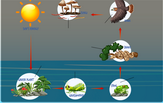Food chain diagram game quiz online
 The food chain illustrates how energy is transferred from one organism to another as a repeating cycle. Several food chains, in turn, compose a single food web for a community. A food chain is a simpler way to describe the steps energy takes as it flows through an ecosystem. The chain begins with producers, such as plants and photosynthetic bacteria. These organisms are able to produce a lot of food by using sunlight as fuel. Consumers occupy the next links of the chain. Unlike producers, they obtain energy by eating other organisms. Primary consumers, or herbivores, refer to organisms that mainly eat plants. Secondary, tertiary, and quaternary consumers either eat other consumers (carnivores) or a mixture of producers and consumers (omnivorous). An organism further along the chain eats the animals in preceding links. The top-level consumer is also called the apex predator. Regardless of which link an organism occupies, when it dies its decaying biomatter is used by decomposers, such as fungi and many invertebrates, to regain the last of its energy. By breaking down their dead matter and wastes, decomposers also return nutrients to the environment to be used by producers anew. If you’re curious about how the flow of energy passes from organism to organism, you can check out our
food chain diagram
and use it as a handy, detailed reference for your life science studies.
The food chain illustrates how energy is transferred from one organism to another as a repeating cycle. Several food chains, in turn, compose a single food web for a community. A food chain is a simpler way to describe the steps energy takes as it flows through an ecosystem. The chain begins with producers, such as plants and photosynthetic bacteria. These organisms are able to produce a lot of food by using sunlight as fuel. Consumers occupy the next links of the chain. Unlike producers, they obtain energy by eating other organisms. Primary consumers, or herbivores, refer to organisms that mainly eat plants. Secondary, tertiary, and quaternary consumers either eat other consumers (carnivores) or a mixture of producers and consumers (omnivorous). An organism further along the chain eats the animals in preceding links. The top-level consumer is also called the apex predator. Regardless of which link an organism occupies, when it dies its decaying biomatter is used by decomposers, such as fungi and many invertebrates, to regain the last of its energy. By breaking down their dead matter and wastes, decomposers also return nutrients to the environment to be used by producers anew. If you’re curious about how the flow of energy passes from organism to organism, you can check out our
food chain diagram
and use it as a handy, detailed reference for your life science studies.
The food chain game
The Food Chain Game is an educational tool that aims to teach players about the relationships between different species in an ecosystem. It is designed to help students understand how energy flows through a system, and how each species plays a role in the cycle of life.
In the game, players take on the role of a predator or prey species, and must navigate their way through different levels, each representing a different ecosystem. As they progress through the game, players will encounter various challenges and obstacles, and must make strategic decisions in order to survive.
At the beginning of each level, players are given a brief overview of the ecosystem they are about to enter, including information about the other species that inhabit it. From there, they must choose their path through the ecosystem, searching for food and avoiding predators as they go.
As players hunt for food, they will encounter different types of prey species, each with their own unique characteristics. Some prey species are fast and agile, making them difficult to catch, while others are slow and easy to catch but provide less nourishment. Players must choose their prey wisely in order to maximize their chances of survival.
In addition to hunting for food, players must also be on the lookout for predators, which can appear at any time and attempt to attack them. Players can defend themselves using a variety of tactics, such as using their superior speed or strength to outmaneuver their attackers, or by using stealth and deception to avoid being detected.
As players progress through the game, they will encounter new and more challenging ecosystems, each with its own set of species and hazards. They will also have the opportunity to evolve and adapt to their environment, unlocking new abilities and traits that will help them survive and thrive in the game.
Overall, the Food Chain Game is a fun and interactive way to learn about the complex relationships between different species in an ecosystem, and how each plays a vital role in the cycle of life. It is an engaging and educational tool that is suitable for students of all ages, and is sure to inspire a lifelong love of learning about the natural world.
